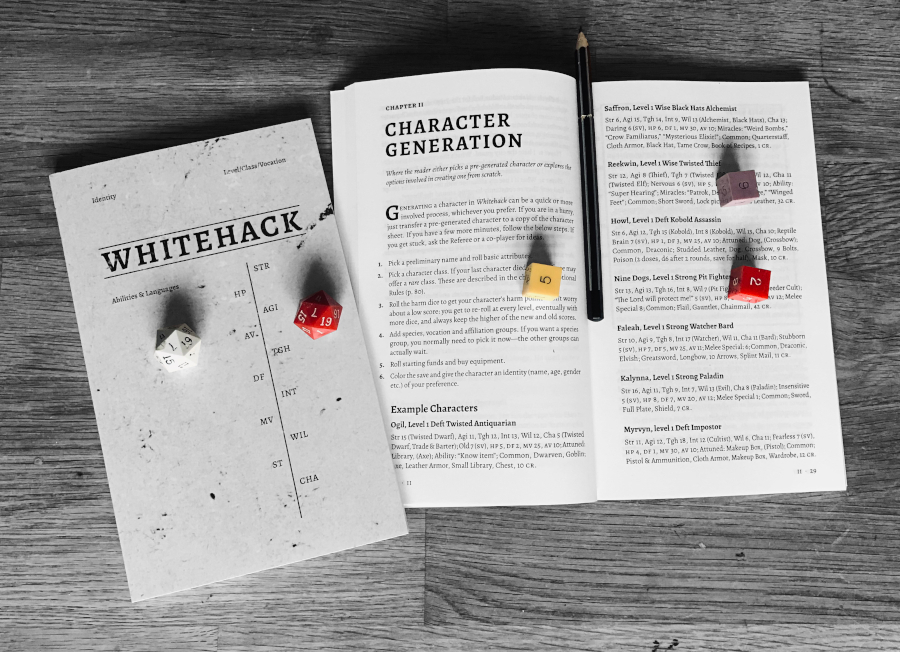
*
Whitehack is a complete fantasy role-playing game in the original tradition. In addition to custom settings and adventures, it can run just about any material from 1974 onwards with great ease and little or no conversion. This works by picking a very limited set of pieces from a traditional, modern or “foreign” stat block and then triangulating them to pin-point how a monster, spell or ability works.
*
Whitehack’s rules are built to meet the demands of long campaigns. It mixes old and new school mechanics to create an emergent game which helps you take your first steps and then keeps challenging you as you become a more experienced player.
*

*
The single book of rules is brief, concentrated and comes in a small format with a traditional layout, completely sans art. This digital version that comes with two hyperlinked, fully bookmarked and optimized PDFs: one for the tablet or computer, and one for the phone.
*
The following was taken form the author’s website
Q: Can you list all the relevant changes from third edition to fourth edition?
I can try, but there are many small changes and tweaks in addition to bigger ones, so I am likely to forget a few! The following is what comes to mind when I flip the 4e book, in no particular order.
- There is no ogl.
- There is a new and more economic layout on a smaller page (novella size). The character sheet is the cover. Page count has gone down from 160 to 144. The only print alternative at release is a softcover. In essence, 4e is more hardcore than 3e, and the smallest Lulu book print of Whitehack to date.
- A lot of places have very minor changes to phrasing, aiming to make the game clearer.
- The game doesn’t require more dice, but in some cases, the d20 is readasad10andthed6isreadasad3.Thisway,youcanalsouse the d100 for foreign modules.
- Some core terminology has changed. This has been done very gently. i Roguelike maps are used throughout the game for things like maps, examples of positioning and blueprints.
- Saves now have “color” in the form of double-edge modulations, like “Old” or “Paranoia.” This gives personality to the character and may affect some rolls.
- The game now uses a “cr” standard for funds—crstanding for either Crowns or Credits.
- Prices have been given a do-over.
- The game uses the following attribute array per default: Strength, Agility, Toughness, Intelligence, Willpower and Charisma.
- Raises are used as a rules value, not just a literal number of attribute raises.
- All classes now require slightly less xp to advance.
- The Deft have been slightly altered through a specification of what happens to lost attunements and an emphasis on distinguishing between active and inactive attunements.
- The Strong have had their looting capacity reworked, making the application broader (conflicts, not just literal fights) and less de- pendent on the Referee. The Berserker ability is gone (you can still berserk though), replaced by a debilitating attack. The Strong are also more viable as a ranged fighter type, through a reworked flow ability. This in turn makes the Strong better adapted to non-fantasy genres.
- The Wise healing ability is better explained and rationalized through the concept of (magick) interference. While the class hasn’t changed in itself, the rules for a few magick aspects have.
- Descriptions of magick effects and concentrations have been re- worked.
- Armor is now controlled by a Defense value, abbreviated df. It works like before.
- The list of gear that you can purchase has been altered.
- There is now a third source of extra languages.
- XP for crowns (gold) has been altered, demanding that funds actually be payed in order to yield xp. This mechanism is also affected by affiliation groups.
- The rules for pushing stuck doors have been improved.
- There is a new terrain type in the table for movement, and the rule for straining have been improved.
- The previous rules for reaction rolls have been replaced by a more rigorous system for attitudes and parley.
- The rules for reach, disengaging, flanking and attacking from behind have been strengthened.
- Helmets have no individual rules anymore.
- The crit-table and the rules for crits have been reworked.
- The special combat options and the weapons table have been slightly tweaked.
- There are now rules for piercing ammunition.
- The rules for hp and death have been tweaked and clarified, including the penalty for failing a save against incoming damage.
- The rules for injuries have been tweaked.
- There is a section on magick interference and healing, specifying the cases in which Wise miracle workers do need potions and professional medicine.

- The rules for scrolls have been slightly tweaked.
- The example substances are now placed next to the rules sections (they were in the magick artifacts chapter before).
- Reputation plays into retainer morale and recruitment.
- The advice for true miracles has been altered to reflect changes in 4e.
- The section on other traditions has been tweaked.
- Combat in ships and vehicles has been greatly improved with a way to handle “3d combat” (such as when fighting in space or under water).
- Building, code-breaking and hacking have been improved.
- There is a section on scaling, detailing how to handle tasks, attacks and damage.
- Corruption now includes less concrete sources, such as despair.
- There is a section on corrupting magick.
- Custom attribute bonuses now includes bonuses to mv.
- Beyond levels now includes save color.
- The Brave class has gotten a new quirk, removing a loophole that could previously be exploited.
- There is a new rare class, called the Clever. In addition to its rare function, it might be used as a default class instead of the Wise (which could then be rare) in low magick campaigns.
- The Fortunate class no longer pays xp to raise their retainers. It happens automatically. There are some changes to the text as well, emphasizing that retainers have opinions about their own station.
- The rules for species classes have been tweaked.
- The text on bases has been very slightly tweaked.
- The text on settings has been partly re-written, providing tools for structural analysis and design.
- Dungeon construction now includes general keys for roguelike dungeons.
- Self-playing characters have been promoted from a footnote to its own section.
- The campaign section now includes rules and advice for handling reputation and competition.
- There is a whole spread on the very powerful concept of macros— large setting phenomena and factions played as characters.
- Monsters now have loot rolls.
- The monster table has had a few entries removed or renamed.
- Boss monsters have rules for partitioning—the ability to wall off a section of their stats.
- The rock snail now comes with a map.
- The list of artifact templates has been slightly shortened and re-named.
- The Tomb of Tunka Jinn is still in the appendix, as a more rigorous list of things to do.
- In the appendix is also a section on how to build setting using macros.
- The index has been expanded to include new concepts.
*
Whitehack Fourth Edition is available at the link here for DriveThruRPG
*


